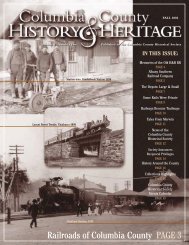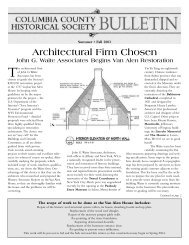Our Incrredible Valley Page 3 - Columbia County Historical Society
Our Incrredible Valley Page 3 - Columbia County Historical Society
Our Incrredible Valley Page 3 - Columbia County Historical Society
Create successful ePaper yourself
Turn your PDF publications into a flip-book with our unique Google optimized e-Paper software.
By Dominic Lizzi<br />
Mr. Lizzi is an author and Valatie Village<br />
Historian. His new book, Valatie; The<br />
Forgotten History is in first draft status.<br />
The mid-nineteenth century was the<br />
heyday of steamboats in America and<br />
on the Hudson River. Indeed,the<br />
Hudson Morning Republican, August 28, 1905<br />
stated: “Early in the nineteenth century the<br />
Hudson River set the pace for speed with magnificent<br />
steamboats.” <strong>Columbia</strong> <strong>County</strong>’s main<br />
ports were the City of Hudson and Stuyvesant<br />
Landing, also called Kinderhook Landing.<br />
Passengers, freight, crops and textile products<br />
were loaded onto the majestic boats<br />
which steamed up and down the Hudson<br />
River. Finished goods, bales of cotton and<br />
passengers were discharged at these ports. The<br />
steamboat, with its chugging engines, smoke<br />
stacks belching black smoke, singing whistles<br />
and splashing paddles, were a common sight<br />
to residents of <strong>Columbia</strong> <strong>County</strong> from the<br />
time the ice melted in the spring until the<br />
waters froze again in the winter. There were<br />
continuing reports on the steamboats, their<br />
schedules, and cargoes in the county newspapers<br />
of the era.<br />
Unfortunately, there are no surviving<br />
Hudson <strong>Valley</strong> steamships as there are on the<br />
Mississippi River. The last steamboats of the<br />
Hudson River Day Line are but<br />
memories of the elderly. There<br />
are scattered momentos in<br />
museums and histories written<br />
that preserve aspects of this<br />
once great river traffic.<br />
However, Valatie, among its<br />
many hidden treasures, has the<br />
most prominent relic of the<br />
Hudson River steamboats. The<br />
Swallow House, a residence<br />
now belonging to Stephen and<br />
Heather Desmonie, is built of<br />
the timbers and other remains<br />
of the Swallow, a vessel that for<br />
nine years plied the river. The<br />
house and its components are<br />
the only known remains of a<br />
steamboat in <strong>Columbia</strong> <strong>County</strong>.<br />
The house is located at 1413<br />
Albany Avenue, and is well doc-<br />
<strong>Columbia</strong> <strong>County</strong> <strong>Historical</strong> <strong>Society</strong> www.cchsny.org<br />
umented in numerous news articles and<br />
books dealing with the steamboats on the<br />
Hudson River. The Desmonies live in the well<br />
maintained two-story frame house with their<br />
children, Dominic and Alexander.<br />
The Swallow was destroyed on April 7,<br />
1845, during a race with two other vessels off<br />
the village of Athens (Figure 2, page 31). The<br />
Swallow struck a rock known as Dooper Island<br />
or Noah’s Brig. The ship was described as “a<br />
beautiful, long, rakish, go-ahead steamboat.”<br />
Shipbuilder William Capes built it in his<br />
Brooklyn shipyard in 1836 for Anthony<br />
Hoffman and Associates. The wooden hull<br />
was 226 feet long and weighed 426 tons. In<br />
1837, the vessel was lengthened to 240 feet in<br />
order to give it better navigation and speed.<br />
The two paddle wheels were about 24 feet in<br />
diameter each and turned at 24 rpm. The West<br />
Point Foundry produced the steam engine<br />
which powered the boat. It was a sleek doubledecker<br />
which could easily accommodate about<br />
300 people, including the crew. The vessel was<br />
worth about fifty thousand dollars in 1840.<br />
Anthracite coal was used for fuel on this<br />
steamboat and most others after 1810<br />
replacing thick pine slabs of wood. However,<br />
pine was often added to the burner for quick<br />
bursts of speed. The main fear of passengers<br />
and crew on these “floating volcanoes” was<br />
the ship catching fire due to exploding boil-<br />
38<br />
ers, a common occurrence during this era.<br />
The Swallow was considered one of the<br />
two fastest steamboats in America and better<br />
than any that plied European waters. By the<br />
early 1840s the Swallow had set records for<br />
the trip between New York City and Albany.<br />
It could easily and safely make the trip in a little<br />
over ten hours. The graceful Swallow was<br />
in a bitter rivalry with other steamboats not<br />
only in speed of travel but also for the passenger<br />
trade. Price wars between existing steamboat<br />
companies often broke out. For example<br />
at one time in 1840, fares that had been originally<br />
set at 7 dollars between Albany and<br />
New York City were cut to 25 cents, and on<br />
some boats nothing at all with passengers paying<br />
for stateroom and meals only.<br />
The rivalry, particularly with regard to<br />
speed and condition of the boats, was a matter<br />
of pride for both captains and crews. Their<br />
reputations often depended on the performances<br />
of the steamboats during the 142 mile<br />
long races on the Hudson between the docks<br />
in Albany and Manhattan. Heavy betting also<br />
The Swallow House<br />
The Swallow House as seen today; a depiction of the wreck of the Swallow is<br />
shown on page 31.<br />
took place between rival owners, captains and<br />
other gamblers.<br />
On the day before the tragedy, April 6,<br />
1845, while speeding upstream, the Swallow<br />
lost a close race to its bitter enemy, the<br />
Rochester. The Rochester was a smaller, sleek<br />
steamboat which was very fast. It was about<br />
210 feet long. The next evening<br />
the captain of the Swallow, A.<br />
H. Squires, was determined to<br />
avenge the loss.<br />
At 6:00 p.m., April 7, the<br />
Swallow cast off from Albany’s<br />
steamboat docks, as this part of<br />
the port was known. At the<br />
same time, two other steamboats,<br />
the Rochester and the<br />
Express also left. Immediately<br />
the boats began racing downstream.<br />
The crews quickly<br />
began shoveling large amounts<br />
of coal into the steam engines.<br />
The boilers began hissing and<br />
making great rumblings. Black<br />
smoke poured from the smoke<br />
stacks of the three boats. When<br />
steamboats raced passengers<br />
often became very frightened











